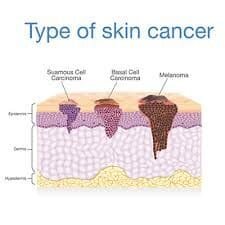Skin Melanoma Cancer is a rare skin disease, but it can adversely affect the infected person upon lack of early detection and treatment. This article will guide our readers regarding Symptoms, Prevention, and Treatment of melanoma skin cancer.
What is Melanoma?
Melanoma is a type of skin cancer that develops from the melanocytes, the cells that produce melanin, the pigment that gives skin its color. Melanoma can appear anywhere on the body, but it is most common on the sun-exposed areas of the skin, such as the face, neck, and back.

What are the Symptoms of Melanoma?
The ABCDEs of melanoma are a helpful way to remember the signs and symptoms of this type of skin cancer:
- Asymmetry: One half of the mole does not match the other half.
- Border: The edges of the mole are irregular or notched.
- Color: The mole is uneven in color, with shades of black, brown, red, or white.
- Diameter: The mole is larger than 6 millimeters (about ¼ inch).
- Evolution: The mole has changed in size, shape, or color over time.
If you notice any of these signs or symptoms in a mole, it is important to see a doctor right away.
What are the Risk Factors for Melanoma?
The following are some of the risk factors for melanoma:
- Fair skin
- A family history of melanoma
- A large number of moles
- A history of sunburns
- Exposure to ultraviolet (UV) radiation
How Can I Prevent Melanoma?
The best way to prevent melanoma is to protect your skin from the sun. You can do this by:
- Wearing sunscreen with an SPF of 30 or higher every day, even on cloudy days
- Wearing protective clothing, such as a hat and sunglasses, when you are outdoors
- Avoiding tanning beds
How Is Melanoma Diagnosed?
A doctor will typically diagnose melanoma based on a physical exam and a biopsy of the mole. A biopsy is a procedure in which a small piece of tissue is removed from the mole and examined under a microscope.
How Is Melanoma Treated?
The treatment for melanoma depends on the stage of the cancer. Early-stage melanoma is usually treated with surgery to remove the cancer. In some cases, radiation therapy or chemotherapy may also be used.
For more advanced melanoma, treatment may include surgery, radiation therapy, chemotherapy, immunotherapy, or a combination of these treatments.
What is the Outlook for Melanoma Patients?
The outlook for melanoma patients depends on the stage of the cancer at the time of diagnosis. Early-stage melanoma is highly curable, but the outlook for more advanced melanoma is less favorable.
Conclusion
Melanoma is a serious type of skin cancer, but it is also one of the most curable cancers if it is detected early. By being aware of the signs and symptoms of melanoma and taking steps to protect your skin from the sun, you can help reduce your risk of developing this disease.
Here are some additional tips for preventing melanoma:
- Avoid tanning beds.
- Get regular skin exams from a doctor.
- Be aware of your family history of melanoma.
- If you have any concerns about a mole, see a doctor right away.
Early detection and treatment of melanoma is essential for a good outcome.
We hope above article on skin melanoma cancer will help our readers to understand the critical skin disease and take precautions.
Thanks for visiting Gymbag4u.com.
GymBag4U – Your Fitness is Our Passion
